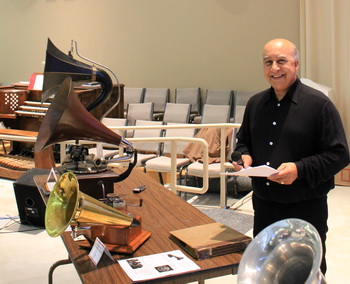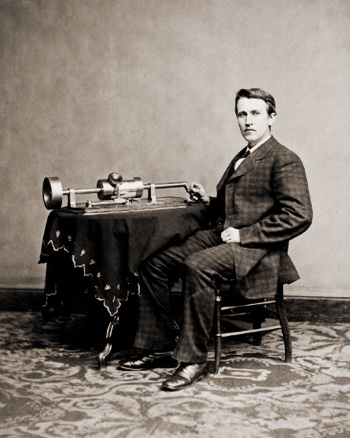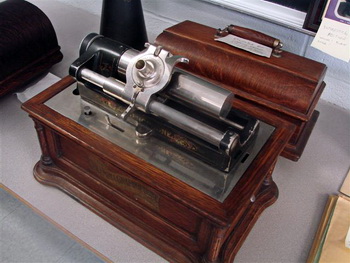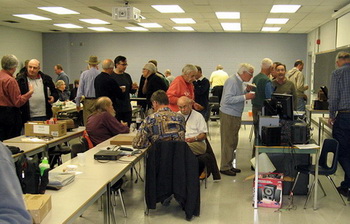|
A Brief History of the Antique Phonograph:
A primer, a reference and just enough to make you knowledgeable!
by Mike Bryan

|
|
At a joint presentation with Keith Wright, CAPS ex-president and indefatigable CAPS ambassador,
Mike Bryan, shares and expands some of his 'Phono 101' .
(Image courtesy Keith Wright)
|
|
|
I’ve always felt that I don’t know much about
phonographs, or perhaps what I really mean
is that I don’t know as much as some other
collectors. No doubt, others think the same way
too, because knowledge is a relative term. This
becomes evident when I’m making a presentation
or displaying phonographs in a public setting,
where my little bit of knowledge sounds positively
encyclopedic to someone who has never even seen
a 78 spinning on a turntable before – oh yes, there
is at least one whole generation of those people.
It’s on such occasions that I realize my retained
knowledge has accumulated over the years from
agreeing to write articles and make presentations.
The preparation for these forces me to gather
and check information from various sources
and to ensure that I understand it well enough to
articulate it in my own words…and sometimes
with my own views.
There are many facets to the subject of antique
talking machines and recorded sound, but when
promoting our hobby to the public through
articles, displays and presentations, it’s often
best to stick to the basics and just tell the story
of the development of the phonograph and
recorded sound. I thought it might be helpful as
a primer for new members and as a reference for
others, to provide a kind of potted history here in
Antique Phonograph News. The history can be
told in many different ways and on one page or
hundreds. What follows is a simple outline of the
story as I have managed to understand it and tell
it to anyone who asks me about my phonograph
collecting hobby. OK, I don’t tell the whole of
even this potted version in one conversation, but
this is the knowledge from which I draw.
A Sure Way to Make You Smile – Play a
Record on an Antique Phonograph
One of the easiest ways to make someone smile is
to play an old record for them on an antique windup
phonograph. They watch and listen in almost
speechless awe as the strange machine brings
back to life the music and sounds of a distant
time and place. They look closer, wondering how
the music can possibly get from that old black
spinning record to the horn and how it can fill the
room with sound.
Well, just over a hundred years ago, many others
were equally fascinated by that same "talking
machine" as they saw it for the first time. From
the beginning of time until 1877, the only way
to listen to music was to be there in front of the
band, musician or singer. There was no way to
capture their sound so that it could be heard again
at a different place or time.
Origins of the Big Three Phonograph
Companies that Changed the World
1. Edison Invents the Phonograph 1877

|
|
A young Thomas Edison with his Phonograph
|
|
|
That all changed when the great inventor, Thomas
Alva Edison, found a way to incise the vibrations
caused by sound onto a piece of tin foil wrapped
around a cylinder. As he rotated the cylinder, he
spoke into a mouthpiece joined to a diaphragm
and stylus. The sound of his voice made the
diaphragm vibrate and caused the attached stylus
to inscribe a track in the tin foil. Then he rotated
the cylinder again, with the stylus naturally
following
the inscribed
track that had
been made
by his voice
vibrations. Lo
and behold,
he heard his
voice play
back the less
than profound
statement he
had made
for such
an historic
moment… "Mary had a little lamb." Edison
called his invention the "phonograph".
Having made this great technological
achievement, Edison suggested a few potential
uses for his invention, such as businessmen
dictating correspondence, announcements by
a talking clock, books for the blind, recording
family voices for posterity and yes, even the
reproduction of music. However, there seemed
to be a lack of focus in developing the tinfoil
phonograph into a commercially viable product to
meet a specific want or need. After all, Edison’s
invention had been made as a side project to the
work he had been doing on telephone transmitters
and he had not set out with a vision for the
purpose of recorded sound, just the will to achieve
it.
Also, there was a major drawback in using tin
foil as the recording medium, because the sound
quality was poor and a recording in tin foil could
be played only once or twice before it became
perforated and unusable. Nevertheless, during
1878/9, tinfoil phonographs were made in small
numbers for demonstration purposes, but the
initial excitement soon wore off and Edison
turned his focus to other inventive projects,
particularly development of the incandescent light
bulb.
2. The Columbia Phonograph Company

|
|
Columbia cylinder Graphophone
(Image courtesy Arthur Zimmerman)
|
|
|
Alexander Graham Bell, an inventor and associate
of Edison, was keen to develop the phonograph
further. Bell shared the same New York City
office building as Edison and some of the same
investors, too. After inventing the telephone in
1876, Bell was somewhat jealous that it had
been Edison, and not he, who had made the
breakthrough in recording and playing back
sound. Edison had been equally peeved that Bell
had beaten him to the invention of the telephone
and that’s why he had been working on improving
the telephone transmitter. It is ironic that it was
this project that prompted Edison’s brainwave
leading to the invention of the phonograph.
Bell’s opportunity to improve on Edison’s
invention came in 1880 when he was awarded
a prize by the government of France for his
invention of the telephone. He used the prize
money to fund a laboratory for research on sound
technology, hiring his cousin, Chichester Bell
and Charles Sumner Tainter, to do the work.
They experimented to find a more permanent
recording medium than tin foil and came up
with a cardboard cylinder coated with wax, into
which the vibrating needle was able to cut a
groove that could be retraced by the needle for
repeated playback. Bell and Tainter also designed
phonographs adapted to play the small diameter
of their cylinders and, in order to distinguish them
from Edison’s machines, they named theirs the
"Graphophone". Their company name was The
American Graphophone Company, but later, after
merging with its American sales agent, it became
the Columbia Phonograph Company.
Turning down an offer to collaborate with Bell
on joint development, Thomas Edison renewed
his phonograph activities in the mid 1880s,
developing a more durable all-wax cylinder and
experimenting with different ways to power the
phonograph by battery, treadle and even water.
The eventual winning mechanism, though, was
the spring motor which would be used by Edison
and his competitors to drive their phonographs for
many years to come.
3. Berliner’s Gram-o-Phone and the Victor
Talking Machine Company

|
|
Emile Berliner with Disc Gramophone
|
|
|
During the 1880s, Emile Berliner, another
inventor who worked on telephone transmitters,
began experimenting with sound recording
techniques. He followed the same basic principles
as Edison, but used a flat disc instead of a
cylinder. Edison had thought of, but rejected, disc
records because of their inner groove distortion.
The machine that Berliner designed to play his
flat records he named the "Gram-o-Phone". By
the way, in North America today collectors tend
to use the term "phonograph" for all "talking
machines", but in Europe the term "phonograph"
is applied to cylinder-playing machines,
while disc-playing machines are referred to as
"gramophones", as per the original designations.
Berliner produced his first commercially-available
gramophone as a toy in Germany. Soon he
introduced new models in the USA, but turning
a disc by hand with a crank created uneven
playback. Berliner realised that his gramophones
would be no more than novelty items unless he
could power them with spring motors like Edison
and Bell/Tainter machines. So he teamed up
with New Jersey machine shop owner, Eldridge
Johnson, whose company began providing motors
for Berliner’s first spring-driven gramophones in
1896.
The following year, Berliner introduced the
"Improved Gram-o-Phone" that is known today as
the "Trademark" model, because of its appearance
in what was to become one of the world’s most
recognised trademarks. In the trademark, Nipper
the dog is seen listening to his master’s voice
speaking from the gramophone’s horn.
By 1900, Emile Berliner’s business was well
established, but the company that marketed his
gramophones became unhappy with the business
arrangement and commenced legal action that
led to Berliner being prohibited from making
or selling his machines and records in the USA.
So he headed north and set up shop on St.
Catherine Street in Montreal and it wasn’t long
before he established factories around the city
to manufacture his Berliner gramophones and
records.
As a result of the injunction against Berliner,
Eldridge Johnson, who had been manufacturing
Berliner’s machines, now had to establish a new
company so that he could continue making and
selling them. As the dust settled in 1901 after
all the legal wrangling, Johnson renamed his
new company "The Victor Talking Machine
Company".
Berliner remained a shareholder in The Victor
Talking Machine Company and maintained
close ties with it. By about 1910, Berliner ceased
making gramophones in Canada, becoming the
sole Canadian distributor of U.S.-made Victor
machines while remaining strong as a producer of
records.
Although the phonograph had been invented
in 1877, it didn’t become a mass market item
until about 1900. In the intervening years, many
companies had tried to cash in on Edison’s
invention and get around the patents registered by
Edison and the companies that were to become
Columbia and Victor. These emerging "big
three" companies, however, managed to sue most
upstarts out of existence for patent infringements
and then made some cross-licensing deals
between themselves, so that they could focus on
meeting burgeoning consumer demand, rather
than be distracted with constant litigation against
each other.
Format Wars

|
|
"Bottom of the line" of Edison internal
horn cylinder players
|
|
|
It was mentioned earlier that Edison had no clear
vision for the phonograph’s use. There were
others, however, who recognised its potential for
providing entertainment and that’s what launched
the industry into a golden age lasting from about
1900 to 1910. There would be an insatiable
appetite for recorded music that Columbia, Edison
and Victor met with continuously improving
technology in phonographs and in the records
themselves.
Edison continued to develop the cylinder record
format, finding ways to increase its playing time
from the 1901 wax two-minute Gold Moulded
Records to the 1908 four-minute Amberol records
and then in 1911, to the more durable four-minute
Blue Amberol celluloid cylinders.
Columbia’s beginnings were in the cylinder
format, but the company recognised the growing
potential for flat disc records, so it produced
machines and records in both formats until about
1910, using the name "Graphophone" on both
cylinder- and disc-playing machines.
Victor stayed with its flat record format, which
proved far easier to mass produce, ship and store
than cylinders. Well before 1910, it was clear
that the format war would be won by the flat
disc record, but Edison continued to introduce
new cylinder players for several years after that
and produced cylinder records right up to the
demise of the Edison Phonograph Company in
1929. Edison did acknowledge the increasing
dominance of the disc format by introducing
his own version of disc phonograph and records
known as Diamond Discs. The records were
uniquely thick and heavy, quite unlike regular
78s, engineered to reduce turntable rumble.
The Diamond Disc record grooves were cut
vertically (often referred to as hill-and-dale),
so that a special stylus would track over the
hills and dales in the groove to pick up the
vibrations and reproduce them as sound. Regular
78 RPM records were cut laterally and played
with a needle that tracked along the sides of the
V-shaped grooves to pick up and reproduce the
sound.
The External Horn Novelty Wears Off
In the early days, a newly acquired phonograph
was proudly displayed as a status symbol, its
ostentatious brass or colourful horn ensuring that
it could not be missed by friends and neighbours.
By about 1910, though, the novelty was wearing
off and a preference developed for more discrete
and elegant "inside-horn" phonographs that
looked more like pieces of furniture with their
doors, grilles and hinged lids. Some were small
table-top models, such as the Edison Amberola 30
and the Victor Victrola series. Others were made
as floor models, standing four to five feet tall
with record storage below and the sound from the
record player emanating through a fancy grille or
open doors.
As the patents of Columbia, Edison and Victor
began to expire, the market for phonographs
became attractive to companies with peripheral
involvement in the industry, such as cabinet
makers
and piano
retailers.
By about
1915 they
were able to
buy generic
mechanical
parts and
hardware
to install in
cabinets of
their own
design and
manufacture,
mostly in
the floormodel
style.
They would
sell these
phonographs
under their
own brand
name, many starting with Phono… or ending
with …ola. Some of these brands didn’t reach far
beyond their local market while others, such as
Brunswick, Cheney, Sonora and Silvertone, were
more widely distributed.
Interest in the phonograph was temporarily
diminished with the introduction of commercial
radio in the early 1920s. Indeed, although portable
suitcase-style wind-up phonographs, introduced
in the teen years, would be made for many years
to come, the radio effectively signalled the end of
the acoustic wind-up phonograph era.
Collecting Antique Phonographs for Fun

|
|
Victor V in oak
cabinet with wooden
"spearpoint" horn for sale at a recent CAPS auction
(Image courtesy Arthur Zimmerman)
|
|
|
Some antique phonograph collectors developed
their interest from childhood memories of
listening to their parents’ or grandparents’
phonographs. Others have stumbled onto one of
these strange machines, couldn’t help smiling
at the sound, and just had to take it home. Then
there are those who have grown up in the age of
incredibly convenient and clear digital sound,
but who are blown away by the beauty of antique
phonographs with their rich oak and mahogany
cases and atmospheric, nostalgic music.
With the older generation passing on, estates
being cleared and others just downsizing, there’s
no shortage of antique phonographs coming onto
the market today. Prices range from a couple of
hundred dollars upwards and both cylinders and
flat 78 RPM records are easy to find. In common
with all forms of antique collecting, it helps to do
some research before jumping in. It’s worth being
able to recognize a fake machine from a real one,
whether the machine is working properly, whether
it has all original parts and what is a fair price
to pay. There are antique phonographs for every
taste and budget; for example, the small, low-cost
external-horn machines like the Edison Gem and
Columbia Q cylinder players that once made it
economical for everyone to own a phonograph….
and then spend far more than the cost of the
machine on buying records over the years. These
are still economical buys today. Then there are the
Edison Home, Standard, Fireside and Triumph,
all popular external-horn cylinder players that
can easily be found for a few hundred to over
a thousand dollars. Victor external-horn disc
machines such as the Victor I, II and III tend to
be a bit pricier, but some Columbia disc machines
can be bought for under $1,000.
When it comes to inside-horn phonographs,
these can be found quite often in antique
markets, usually in the $300 - $700 range.
The Edison Amberola 30 cylinder player or its
larger siblings can be good buys. Victor tabletop
and floor-model disc machines are often
seen, but sometimes in need of some light
cosmetic restoration that is always worth the
effort. Original and reproduction spare parts can
usually be found for Columbia, Edison and Victor
phonographs. Some of the more exotic top-ofthe-
line phonographs made by the "big three"
companies are rare and desirable today, because
they were made in small quantities. Eventually
many other brands appeared, as creative
techniques were found to avoid the "big three’s"
patents or the patents expired. Berliner and
Zonophone were both forerunners of the Victor
brand, while others such as Busy Bee, Yankee
Prince, Aretino, Lakeside and the European Pathé
and Excelsior brands are also sometimes found
in Canada. Phonographs labelled as HMV and
Edison Bell are European versions of Victor and
Edison machines, respectively, that have arrived
in Canada with their immigrant owners.
The Benefits of Joining a Phonograph Club

|
|
The auction tables were overflowing at a recent CAPS meeting
(Image courtesy Betty Pratt)
|
|
|
It is always a little sad to find phonographs that
have been neglected at one point or another
during their long lives, but the good news is that
they can be restored. It’s also good to reflect that
once they are back in original condition, they will
most likely live on forever as treasured antiques,
not just the old junk that they once became when
they were merely old and outdated.
There is a surprisingly large number of people
interested in antique phonographs and records.
Some have huge collections, while others are
content with one phonograph and a selection
of classical, hot jazz, vaudeville or early blues
records. Many of them like to learn from and
share their interests with others, so they join the
Canadian Antique Phonograph Society (CAPS).
The club’s 250 members receive a bi-monthly
newsletter full of interesting and entertaining
information on phonographs, the inventors,
restoration, records, performers and much more.
Those within driving distance of Toronto can
attend eight meetings a year where upwards
of 50 members gather on a Sunday afternoon
to have fun together, enjoying an entertaining
presentation, some social time and an auction of
phonographs, records, parts, books and anything
to do with this hobby. The members’ section of
the CAPS web site at << www.capsnews.org >>
gives access to years of the club’s newsletters,
with an index making it easy to find articles on a
wide range of phonograph-related topics.

|
|
Some of the 55 members and guests at a 2012 CAPS meeting
(Image courtesy Betty Pratt)
|
|
|
Joining CAPS is the best way to learn from the
experience of members who are always keen
to help new people make the right choice if
they are wanting to buy a phonograph, learn
how to look after it and fully enjoy it. Some
develop an interest in the history, learning about
the inventors, the technical developments, the
recording artists and record companies. They
are fascinated to see history repeating itself in
the format wars with similar tactics being used
to introduce Blu-ray discs as with Edison’s Blue
Amberols in 1911.
The great thing about collecting antique
phonographs and records is that they don’t just
sit there looking pretty; they perform and are fun
to watch in action as they bring to life the sounds
from a different age, captured for ever in the
records’ grooves. It’s almost like sitting outside
a room where it’s still 1905 or 1922 inside and
hearing the music coming through the walls.
So there you have it – a brief history and more
knowledge about the early phonograph than
99.735% (according to my own estimates) of
the population. Perhaps you’ll be able to use this
to inspire interest in others, particularly young
people, who always seem to smile when they hear
a record played on an antique phonograph and
start asking questions.
Sources:
- "Discovering Antique Phonographs 1877-1929" and "The Talking Machine An Illustrated
Compendium 1877-1929" by Timothy C Fabrizio
and George F Paul
- "The Berliner Gramophone, An Illustrated
History" by Mark Caruana
|